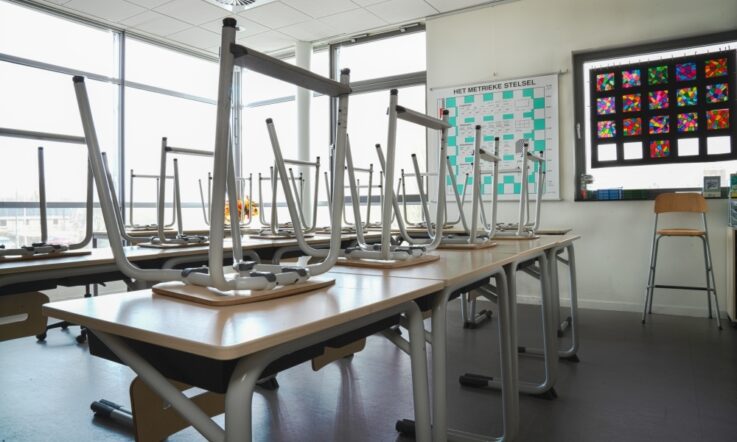Thanks for listening to this episode of Teacher Staffroom, where we catch you up on the latest evidence, insight, and action. I'm Rebecca Vukovic.
In 2015, Teacher columnist and ACER CEO Professor Geoff Masters penned a column for Teacher on the ‘big five’ education challenges facing Australian schools. This influential column remains the most popular article to ever be published on Teacher, collecting hundreds of thousands of page views over the past six years.
This year, ACER decided to hold a five-part webinar series to revisit the big five challenges and ask what progress has been made on each, and what needs to happen next? To date, three of the webinars have already taken place, and in today’s podcast, we’ll be exploring each of them and providing details on how you can catch the next two, which will take place in May. By the way, if you’ve missed any of the earlier webinars, not to worry, they’ve all been recorded and I’ll provide links on how to watch them in the transcript of this episode.
As always, I’ll also be sharing some of the other popular pieces that were published on Teacher this month, and provide links to the articles if you’re interested in learning more about a particular topic or issue. It’s a big episode with lots to cover, so let’s jump straight in.
The first webinar took place in late February, and explored equipping students for the 21st Century. In a Teacher article, we reflected on the session and some of the issues explored by Dr Claire Scoular, Jonathan Heard, and Dr Esther Care. Claire told the webinar audience one of the biggest advancements made in the last six years has been in deepening our understanding of 21st Century skills and how they can be developed. She said: ‘That’s been through a process of hypothesising what the skills look like in a detailed way and then trying to validate that through the process of gaining assessment data and using expert judgement.’
The next article I’d like to share with you today was co-authored by Jo Earp, Dr John Ainley and Dr Tanya Vaughan, and it explored reducing disparities for school students, one of the issues identified in Geoff’s original article. The authors say that disparities among schools in student achievement arise through differences in the social composition of schools, and differences in student learning within schools. They also argue that some actions to ensure that between-school disparities do not grow again depend on actions by school systems, such as limiting the growth of differentiated secondary schools and providing support for continuous school improvement through the development of school leadership and professional learning for teachers.
In the third webinar, Dr Sue Thomson – ACER Deputy CEO (Research), and manager of PISA in Australia – was joined by he Smith Family's Head of Research and Advocacy Anne Hampshire and Victorian secondary teacher Steven Kolber to look at Australia's 'long tail' of underachievement. In this column for Teacher, Sue explores the issue in an Australian context, and discusses the progress made in recent years.
Here’s a quote from Sue’s column:
One of the biggest challenges facing educators is to find better ways to meet the learning needs of the many students who fall behind in our schools. The latest findings from PISA (the Programme for International Student Assessment) show that in Australia, roughly one-in-five 15-year-olds are failing to achieve the international baseline proficiency level in reading literacy, and about the same proportion in mathematical literacy and scientific literacy. This is Australia’s ‘long tail’ of underachievement.
This international baseline of proficiency is set at a fairly low level – these are the students that the OECD has deemed are unable to demonstrate the capacity to use their reading literacy skills to acquire knowledge and solve a wide range of practical problems. It is considered the baseline proficiency at which students are able to participate fully in society.
The final two webinars will be on Wednesday 5 May and Wednesday 19 May. The first is called Getting all children off to the best start in life, and the next one is on Raising the professional status of teaching. Registrations are already open for the fourth webinar, just click on the link in the transcript of this podcast. Stay tuned for articles on both of these topics, and details of how to register for the final event.
Moving on from the big five challenges now, this month the findings of Australia’s annual snapshot of principal health and wellbeing were released. Now in its tenth year, the Australian Principal Occupational Health, Safety and Wellbeing Survey was carried out by researchers at Australian Catholic University and Deakin University. It involved over 2200 school leaders from all sectors, and across all states and territories.
It found that extremely long hours and constant exposure to stress left school leaders exhausted in 2020, as fires, floods, and the pandemic pushed them to their limits. Here’s a quote from the report.
The continual strain of having to deal with an emotionally and physically demanding work environment was reflected in the worsening of school leaders’ long-term health indicators in 2020, when compared to 2019. School leaders, as a group, are at risk of fatigue, mental health decline, and burnout.
I’ll pop a link to the final report in the transcript of this episode, if you’re interested in reading more about the survey data, as well as the recommendations and strategies.
Looking back on the past month on Teacher, I noticed that we’ve published a whole lot of wonderful contributions and reader submissions from educators and academics around the country. I thought I’d whip through some of them now, to give you a quick snapshot of some of articles you may have missed. You’ll find all of them in our archive on the Teacher website.
The first was a piece co-written by Kim Brady and Scott Dirix from Indie School Elizabeth in South Australia. They share details on how they implemented a school-wide wellbeing framework and curriculum that responded specifically to the needs of staff and students.
We also published a contribution from Learning Specialist Jeanette Breen. It was a follow-up to her recent piece how on her school, Templestowe Heights Primary School in Victoria, has improved their writing moderation process. In this piece she describes a new step that aims to bridge the gaps that still exist for staff, through an assessment process known as comparative judgement.
Greg Whitby, a regular Teacher contributor and Executive Director of Schools in the Catholic Diocese of Parramatta in New South Wales, is back with his first video contribution for the new school year. In this video, Greg sits down with Renee Blyth from Xavier College in western Sydney, to discuss how staff have maintained a culture of continuous change at the school.
In a new reader submission, Margaret Gurney, Assistant Director-General, State Schools Operations at the Queensland Department of Education, shares research findings on practices common in high performing schools. She explores: how do schools successfully engage and retain students alongside promoting academic achievement?
And, most recently, Dr Karin Oerlemans, a Principal Consultant at Kairos Consultancy and Training, penned a piece on planning, implementing and monitoring student group work. She discusses the key steps to a successful experience, and how they can be supported by technology.
To finish off today’s episode, I thought I’d give you a bit of a preview on what to expect on the next issue of Wellbeing by Teacher, our new wellbeing publication. I recently spoke to Dr Aimee Dordevic from Monash University on the role of diet in inflammation. We discuss what inflammation is exactly, how we measure it in the body, and which foods help to lower inflammation. If you want to miss this issue, make sure you subscribe to the newsletter. It’s free and you’ll find the sign-up form on the Teacher magazine homepage.
That's all for this episode, and you're now all caught up on the latest evidence, insight and action. Links to all the content and resources I've mentioned will be in the transcript of this podcast, available at our website, teachermagazine.com.
Catch up on the big five webinars:



